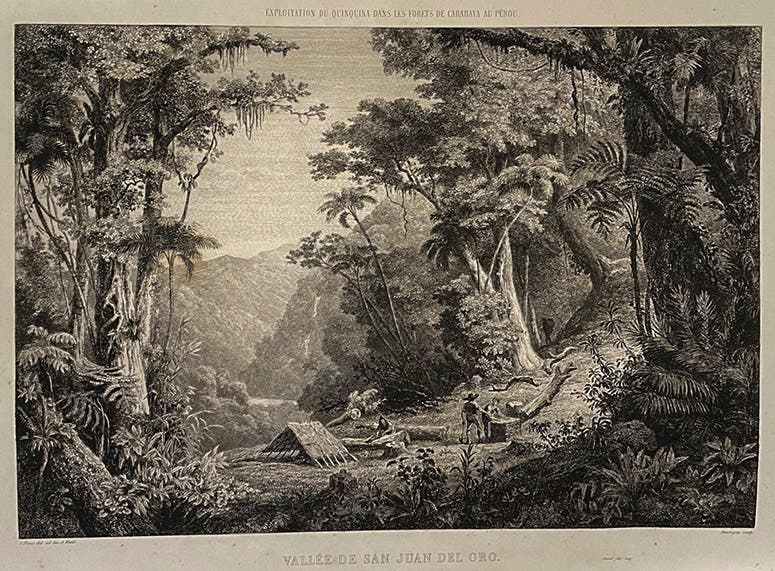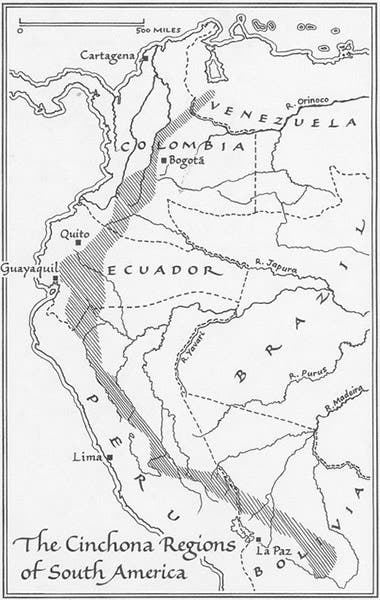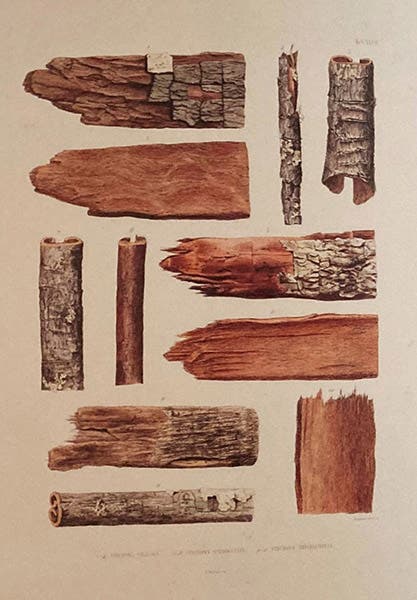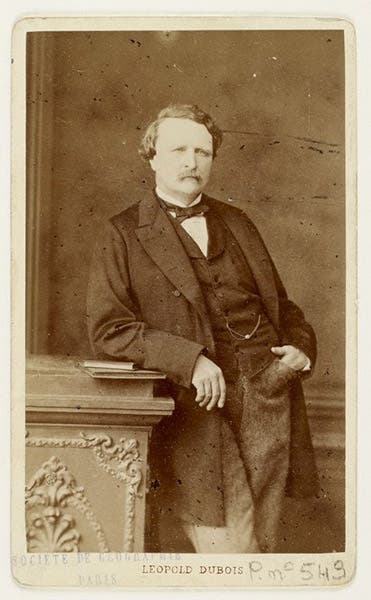Scientist of the Day - Hugh Algernon Weddell

Harvesting Cinchona in the forests of Bolivia, frontispiece engraving, in Hugh A. Weddell, Histoire naturelle des quinquinas, 1849 (collection of Tom Taylor; photo by Tom Taylor)
Hugh Algernon Weddell, an English/French botanist, was born June 22, 1819, at an estate near Gloucester, but he was raised and spent his entire career in France or in the service of France in South America. He earned a medical degree and was thus interested in the medicinal virtues of plants, and one of the most intriguing of these was the Cinchona tree, a native of the foothills of the Andes in Bolivia, Peru, and Ecuador, the bark of which is the source of quinine, the only known remedy for the symptoms of malaria. When François-Louis de Caumont Laporte, comte de Castelnau, was sent on an expedition to South America in 1843, Weddell was sent along by the Paris Museum of Natural History, with secret instructions to detach himself from the expedition and go to Peru and Bolivia in search of Cinchona trees. The goal was to identify new species and bring back seeds that could be raised in the Jardin des Plantes and then exported to sites in the East Indies that might be suitable for growing Cinchona.
Weddell spent two years with the de Laporte expedition (1843-45) and then several years on his own in Bolivia, where he identified a total of 21 species of Cinchona, of which four were new. He made sketches of the leaves and bark of the various Cinchona trees he encountered, and one wonderful drawing of a Cinchona forest with the bark being gathered (first image). He returned home to relinquish his seeds to the Jardin des Plantes and write and publish a book, Histoire naturelle des quinquinas (1849), in which he described his adventures and botanical discoveries and converted his drawings to engravings and lithographs.

The Cichona regions of South America, map by Stephen Raw, used with permission by Tom Taylor, Pyretologia (Alibi 3), 2022 (photo by Tom Taylor)
We do not have any of Weddell's publications in our Library. I first encountered Weddell in the pages of Alibi 3, an occasional (and now annual) publication by Tom Taylor, noted Austin rare book dealer and fine press printer, now retired from printing and book dealing, but not from collecting and reading. Three years ago, Tom decided to select a few books from his personal collection that had a common theme and write about them, weaving events from his life into his observations of the books before him. Having been a fine press printer, he could not resist printing up his musings in handsome fashion, with exquisite paper bindings. Alibi 1 (2020) had a press run of about 100 copies, and Tom did not sell these, but sent them out to surprised recipients of his own choosing, his gift back to the world of book collectors and those who appreciate fine printing. I have no idea how I ended up on the recipient list, but I am extremely grateful, for it is a genuine pleasure to read about Tom's encounters with books. It is unusual for book dealers to actually read their wares, but Tom is nothing if not unusual, and he has owned some remarkable books, pamphlets, and manuscripts, which he writes about lovingly and with the perspective of both a collector and a printer.

Title page and frontispiece of Pyretologia, by Tom Taylor, the third in a now annual series of occasional writings inspired by rare books; the series has the running title Alibi; the frontispiece is a chromolithograph of cinchona bark from various varieties, from Histoire naturelle des quinquinas, by Hugh A. Weddell, 1849 (photo by the author of my copy of Alibi 3)
So Alibi 3, which I received last summer (2022), was called Pyretologia, and the tongue-in-cheek subtitle explains what it is all about (fourth image):
Being a succinct study of the intermittent fevers known as malaria, with accounts of sundry men of varying reputation involved in the discovery and dissemination of the wondrous cure concealed in the bark of certain species of trees in the genus Cinchona, found in remote regions of the Andes of Ecuador, Peru, and Bolivia. With digressions on the pleasures of gin & tonic.
I first encountered Hugh Weddell right opposite the title page of Alibi 3, although I did not know at the time that the beautiful plate of tree bark was from Weddell’s 1849 book on Cinchona (see sixth image for a closer view of the frontispiece). I soon learned that Tom not only owns a copy of Weddell’s Histoire naturelle des quinquinas, but he has a notebook that Weddell kept on his second journey to South America, as well as the publication that resulted from this second expedition: Voyage dans le nord de la Bolivie… (1853). I tried to find a way to paraphrase Tom’s description of the manuscript notebook, but could not, so here are Tom’s own words:
“A paragraph on alpacas is followed by two pages about coca [fifth image, below]; several pages following describe the principal fruits and vegetables cultivated around La Paz. There are local maps of villages, geological cross sections, Quichua (a Quechuan language) vocabularies, a detailed table of Peruvian exports and imports for 1847, colored-pencil sketches of red and white potatoes, barometric records, and itineraries for Weddell’s journey from La Paz to Arequipa, which include the usual complaints about bad food, cold and mud, incessant wind, and the weight of geological specimens.”

Growing coca in terraced gardens, drawing and notes by Hugh A. Weddell, field notes for second expedition to Peru and Bolivia, 1851-52 (collection of Tom Taylor; photo by Tom Taylor)
I do not know if Weddell’s seeds produced a burgeoning quinine industry in French colonies, because everything I know about Weddell, I learned from Tom Taylor, and he soon turned his attention in Alibi 3 to Richard Spruce, another Cinchona gatherer, and left Weddell behind. I naturally asked Tom if he would like to write this post, but he politely declined. However, he did send me photos of the Weddell manuscript that he owns, and another of the frontispiece to Weddell’s first book, so this is still very much his post, even if I put it together. My only contribution was to find the carte de visite portrait of Weddell in the Bibliothèque nationale de France (second image).

The bark of various species of Cinchona trees, chromolithograph, Histoire naturelle des quinquinas, by Hugh A. Weddell, 1849, used as the frontispiece to Pyretologia (Alibi 3), by Tom Taylor (photo by Tom Taylor
If you would like your own copies of Alibi 1, 2 or 3, you are out of luck, since the print run is exhausted, and I am not sure how many copies, if any, ended up in public collections. If you are ever near my office, you are welcome to look at my copies. In 2021, the Austin Book Arts Center commissioned a 22-minute documentary film about W. Thomas Taylor (our Tom Taylor). It is a wonderful tribute to a remarkable bookman. You may view it here. Alibi 1 and Alibi 2 make a brief appearance near the end.
William B. Ashworth, Jr., Consultant for the History of Science, Linda Hall Library and Associate Professor emeritus, Department of History, University of Missouri-Kansas City. Comments or corrections are welcome; please direct to ashworthw@umkc.edu.







